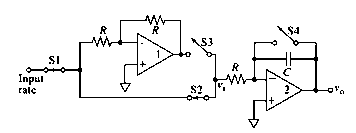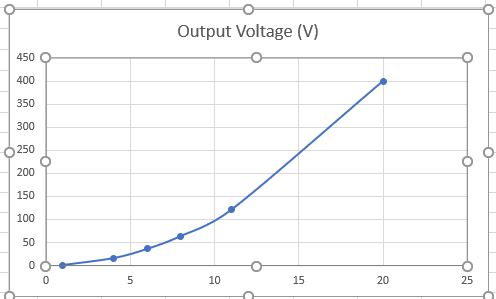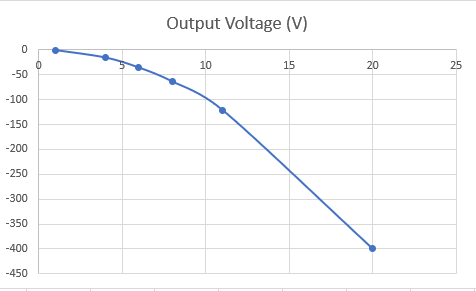
(a)
Interpretation:
The function of the operational amplifier 1 should be determined.
Concept introduction:
The operational amplifier is a high gain device and it amplifies the voltage. Generally, a voltage amplifier has a single output and differential input. So, basically, an operational amplifier produces an output much higher than the input voltage. The output voltage could be thousands of times higher than the input voltage.
Here, the given electronic circuit is as below:

Explanation of Solution
Given information:

The operational amplifier is a high gain device and it amplifies the voltage. Generally, a voltage amplifier has a single output and differential input. So basically, an operational amplifier produces an output much higher than the input voltage. The output voltage could be thousands of times higher than the input voltage.
Here the given electronic circuit is as below:

It can be seen that the operational amplifier 1 here performing the function of inverting voltage amplifier.
(b)
Interpretation:
The function of the operational amplifier 2 should be determined.
Concept introduction:
The operational amplifier is a high gain device and it amplifies the voltage. Generally, a voltage amplifier has a single output and differential input. So, basically, an operational amplifier produces an output much higher than the input voltage. The output voltage could be thousands of times higher than the input voltage.
Here the given electronic circuit is as below

Explanation of Solution
The operational amplifier is a high gain device and it amplifies the voltage. Generally, a voltage amplifier has a single output and differential input. So basically, an operational amplifier produces an output much higher than the input voltage. The output voltage could be thousands of times higher than the input voltage.
Here the given electronic circuit is as below:

It can be seen that the operational amplifier 2 here performing the function of integrating circuit and hence the integration.
(c)
Interpretation:
The output voltage during the interval
Concept introduction:
The operational amplifier is a high gain device and it amplifies the voltage. Generally, a voltage amplifier has a single output and differential input. So, basically, an operational amplifier produces an output much higher than the input voltage. The output voltage could be thousands of times higher than the input voltage.
Here the given electronic circuit is as below

Explanation of Solution
The operational amplifier is a high gain device and it amplifies the voltage. Generally, a voltage amplifier has a single output and differential input. So basically, an operational amplifier produces an output much higher than the input voltage. The output voltage could be thousands of times higher than the input voltage.
Here the given electronic circuit is as below:

Here the input voltage
Where
As per the problem switches
Here, the output signal can be given by the formula as below
Now assume
Substitute the values in the above equation and simplify, the result obtained is
The integrating voltage at different time intervals is given as:
| Time(s) | Output Voltage (V) |
| 1 | 1 |
| 4 | 16 |
| 6 | 36 |
| 8 | 64 |
| 11 | 121 |
| 20 | 40 |
The plot can be obtained as shown below:

(d)
Interpretation:
The output voltage during the second interval
Concept introduction:
The operational amplifier is a high gain device and it amplifies the voltage. Generally, a voltage amplifier has a single output and differential input. So, basically, an operational amplifier produces an output much higher than the input voltage. The output voltage could be thousands of times higher than the input voltage.
Here the given electronic circuit is as below

Explanation of Solution
The operational amplifier is a high gain device and it amplifies the voltage. Generally, a voltage amplifier has a single output and differential input. So basically, an operational amplifier produces an output much higher than the input voltage. The output voltage could be thousands of times higher than the input voltage.
Here the given electronic circuit is as below

Here the input voltage
Where
As per the problem switches
Here the output signal can be given by the formula as below
Where
Therefore, it can be said that
The output of the second operational amplifier which is actually the final output can be given by the equation as below:
Where
Now assume
Substitute the values in the above equation and simplify, the result obtained is
The integrating voltage at different time intervals is given as:
| Time(s) | Output Voltage (V) |
| 1 | -1 |
| 4 | -16 |
| 6 | -36 |
| 8 | -64 |
| 11 | -121 |
| 20 | -40 |
The plot can be obtained as shown below:

(e)
Interpretation:
The output voltage
Concept introduction:
The operational amplifier is a high gain device and it amplifies the voltage. Generally, a voltage amplifier has a single output and differential input. So, basically, an operational amplifier produces an output much higher than the input voltage. The output voltage could be thousands of times higher than the input voltage.
Here the given electronic circuit is as below

Explanation of Solution
The operational amplifier is a high gain device and it amplifies the voltage. Generally, a voltage amplifier has a single output and differential input. So basically, an operational amplifier produces an output much higher than the input voltage. The output voltage could be thousands of times higher than the input voltage.
Here the given electronic circuit is as below

Since there is no current so capacitor will discharge. And circuit will act as differentiator.
Further, it can be re-written as
The output can be given as
(f)
Interpretation:
The advantages and disadvantages of the given circuit over the normal amplifier should be described.
Concept introduction:
The operational amplifier is a high gain device and it amplifies the voltage. Generally, a voltage amplifier has a single output and differential input. So, basically, an operational amplifier produces an output much higher than the input voltage. The output voltage could be thousands of times higher than the input voltage.
Here the given electronic circuit is as below

Explanation of Solution
The operational amplifier is a high gain device and it amplifies the voltage. Generally, a voltage amplifier has a single output and differential input. So basically, an operational amplifier produces an output much higher than the input voltage. The output voltage could be thousands of times higher than the input voltage.
Here the given electronic circuit is as below

Since there is no current so capacitor will discharge. And circuit will act as differentiator.
In general, the normal operational amplifier circuit can be used as a differentiator circuit only. But the given integrating circuit can be used as differentiator as well as integrator. Just one disadvantage is that the given circuit has higher noise level as compared to the normal circuit.
(g)
Interpretation:
The scenario if the input signal gets changes with the slope during the measurement cycle should be determined.
Concept introduction:
The operational amplifier is a high gain device and it amplifies the voltage. Generally, a voltage amplifier has a single output and differential input. So, basically, an operational amplifier produces an output much higher than the input voltage. The output voltage could be thousands of times higher than the input voltage.
Here the given electronic circuit is as below

Explanation of Solution
The operational amplifier is a high gain device and it amplifies the voltage. Generally, a voltage amplifier has a single output and differential input. So basically, an operational amplifier produces an output much higher than the input voltage. The output voltage could be thousands of times higher than the input voltage.
Here the given electronic circuit is as below

Since there is no current so capacitor will discharge. And circuit will act as differentiator.
The output of the second operational amplifier which is actually the final output can be given by the equation as below:
Where
Now assume
Substitute the values in the above equation and simplify, the result obtained is
Further it can be written that
(h)
Interpretation:
The result obtained if the two-time intervals are separated by a time delay
Concept introduction:
The operational amplifier is a high gain device and it amplifies the voltage. Generally, a voltage amplifier has a single output and differential input. So, basically, an operational amplifier produces an output much higher than the input voltage. The output voltage could be thousands of times higher than the input voltage.
Here the given electronic circuit is as below

Explanation of Solution
The operational amplifier is a high gain device and it amplifies the voltage. Generally, a voltage amplifier has a single output and differential input. So basically, an operational amplifier produces an output much higher than the input voltage. The output voltage could be thousands of times higher than the input voltage.
Here the given electronic circuit is as below

For the given circuit the during the first time interval
Now if the two-time intervals are separated by a time delay
(i)
Interpretation:
The result if the two-time intervals were of different duration should be determined.
Concept introduction:
The operational amplifier is a high gain device and it amplifies the voltage. Generally, a voltage amplifier has a single output and differential input. So, basically, an operational amplifier produces an output much higher than the input voltage. The output voltage could be thousands of times higher than the input voltage.
Here the given electronic circuit is as below

Explanation of Solution
The operational amplifier is a high gain device and it amplifies the voltage. Generally, a voltage amplifier has a single output and differential input. So basically, an operational amplifier produces an output much higher than the input voltage. The output voltage could be thousands of times higher than the input voltage.
Here the given electronic circuit is as below

As its known that, if the two-time intervals are same then the plot of the output voltage is same in magnitude and opposite in sign for both the interval. But if the two-time intervals are of different duration then the magnitude of output signal will be different for both the time periods.
(j)
Interpretation:
The reason should be discussed for why the time interval is desirable to be as large as possible in measuring enzyme
Concept introduction:
The operational amplifier is a high gain device and it amplifies the voltage. Generally, a voltage amplifier has a single output and differential input. So, basically, an operational amplifier produces an output much higher than the input voltage. The output voltage could be thousands of times higher than the input voltage.
Here the given electronic circuit is as below:

Explanation of Solution
The operational amplifier is a high gain device and it amplifies the voltage. Generally, a voltage amplifier has a single output and differential input. So basically, an operational amplifier produces an output much higher than the input voltage. The output voltage could be thousands of times higher than the input voltage.
Here the given electronic circuit is as below

Since there is no current so capacitor will discharge. And circuit will act as differentiator.
The output of the second operational amplifier which is actually the final output can be given by the equation as below:
Where
Now, assume
Substitute the values in the above equation and simplify, the result obtained is
If the time gets larger then the output voltage also gets larger.
Enzyme kinematics are generally time-consuming process. So, its desirable to have larger time.
Want to see more full solutions like this?
Chapter 3 Solutions
Principles of Instrumental Analysis
- Part 9 of 9 Consider the products for the reaction. Identify the major and minor products. HO Cl The E stereoisomer is the major product and the Z stereoisomer is the minor product ▼ S major product minor productarrow_forwardConsider the reactants below. Answer the following questions about the reaction mechanism and products. HO Clarrow_forwardjulietteyep@gmail.com X YSCU Grades for Juliette L Turner: Orc X 199 A ALEKS - Juliette Turner - Modul X A ALEKS - Juliette Turner - Modul x G butane newman projection - Gox + www-awa.aleks.com/alekscgi/x/Isl.exe/10_u-IgNslkr7j8P3jH-IBxzaplnN4HsoQggFsejpgqKoyrQrB2dKVAN-BcZvcye0LYa6eXZ8d4vVr8Nc1GZqko5mtw-d1MkNcNzzwZsLf2Tu9_V817y?10Bw7QYjlb il Scribbr citation APA SCU email Student Portal | Main Ryker-Learning WCU-PHARM D MySCU YSCU Canvas- SCU Module 4: Homework (Ch 9-10) Question 28 of 30 (1 point) | Question Attempt: 1 of Unlimited H₂SO heat OH The mechanism of this reaction involves two carbocation intermediates, A and B. Part 1 of 2 KHSO 4 rearrangement A heat B H₂O 2 OH Draw the structure of A. Check Search #t m Save For Later Juliet Submit Assignm 2025 McGraw Hill LLC. All Rights Reserved. Terms of Use | Privacy Center | Accessarrow_forward
- The electrons flow from the electron-rich atoms of the nucleophile to the electrons poor atoms of the alkyl halide. Identify the electron rich in the nucleophile. Enter the element symbol only, do not include any changes.arrow_forwardHello, I am doing a court case analysis in my Analytical Chemistry course. The case is about a dog napping and my role is prosecution of the defendant. I am tasked in the Area of Expertise in Neutron Activation and Isotopic Analysis. Attached is the following case study reading of my area of expertise! The landscaping stone was not particularly distinctive in its decoration but matched both the color and pattern of the Fluential’s landscaping stone as well as the stone in the back of the recovered vehicle. Further analysis of the stone was done using a technique called instrumental neutron activation analysis. (Proceed to Neutron Activation data) Photo Notes: Landscaping stone recovered in vehicle. Stone at Fluential’s home is similar inappearance. Finally, the white paint on the brick was analyzed using stable isotope analysis. The brick recovered at the scene had smeared white paint on it. A couple of pieces of brick in the back of the car had white paint on them. They…arrow_forwardCite the stability criteria of an enamine..arrow_forward
- What would you expect to be the major product obtained from the following reaction? Please explain what is happening here. Provide a detailed explanation and a drawing showing how the reaction occurs. The correct answer to this question is V.arrow_forwardPlease answer the question for the reactions, thank youarrow_forwardWhat is the product of the following reaction? Please include a detailed explanation of what is happening in this question. Include a drawing showing how the reagent is reacting with the catalyst to produce the correct product. The correct answer is IV.arrow_forward
 Physical ChemistryChemistryISBN:9781133958437Author:Ball, David W. (david Warren), BAER, TomasPublisher:Wadsworth Cengage Learning,
Physical ChemistryChemistryISBN:9781133958437Author:Ball, David W. (david Warren), BAER, TomasPublisher:Wadsworth Cengage Learning, Chemistry for Engineering StudentsChemistryISBN:9781285199023Author:Lawrence S. Brown, Tom HolmePublisher:Cengage Learning
Chemistry for Engineering StudentsChemistryISBN:9781285199023Author:Lawrence S. Brown, Tom HolmePublisher:Cengage Learning Principles of Instrumental AnalysisChemistryISBN:9781305577213Author:Douglas A. Skoog, F. James Holler, Stanley R. CrouchPublisher:Cengage Learning
Principles of Instrumental AnalysisChemistryISBN:9781305577213Author:Douglas A. Skoog, F. James Holler, Stanley R. CrouchPublisher:Cengage Learning Principles of Modern ChemistryChemistryISBN:9781305079113Author:David W. Oxtoby, H. Pat Gillis, Laurie J. ButlerPublisher:Cengage Learning
Principles of Modern ChemistryChemistryISBN:9781305079113Author:David W. Oxtoby, H. Pat Gillis, Laurie J. ButlerPublisher:Cengage Learning




